International Business Law: Legal Issues in a Start-up Textile Firm
VerifiedAdded on 2023/06/11
|10
|2621
|241
Case Study
AI Summary
This case study examines the potential legal issues facing a start-up textile business specializing in fabric design and dyeing. It identifies key challenges related to intellectual property rights (copyright, trademark, and patent infringement), employment laws (wage violations, working conditions, and employee rights), and health and safety regulations (risks associated with dyes, fire hazards, and workplace safety). The analysis emphasizes the importance of protecting intellectual property through registration and enforcement, ensuring fair labor practices by adhering to minimum wage laws and providing safe working conditions, and implementing comprehensive health and safety policies to mitigate risks and ensure employee well-being. The case study also highlights the role of trade unions and technological monitoring in safeguarding employee rights and promoting a compliant and ethical business environment. Desklib offers more solved assignments and resources for students.
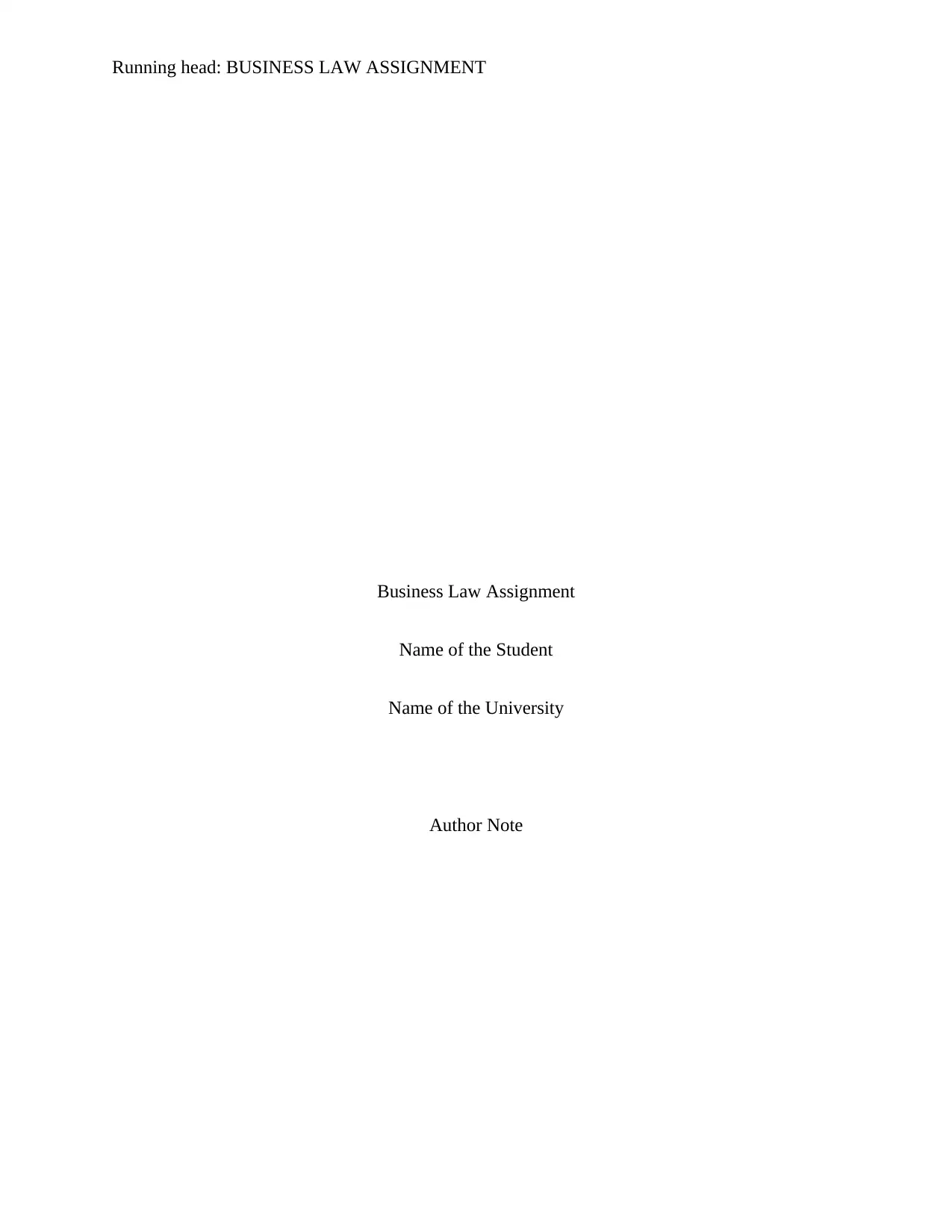
Running head: BUSINESS LAW ASSIGNMENT
Business Law Assignment
Name of the Student
Name of the University
Author Note
Business Law Assignment
Name of the Student
Name of the University
Author Note
Paraphrase This Document
Need a fresh take? Get an instant paraphrase of this document with our AI Paraphraser
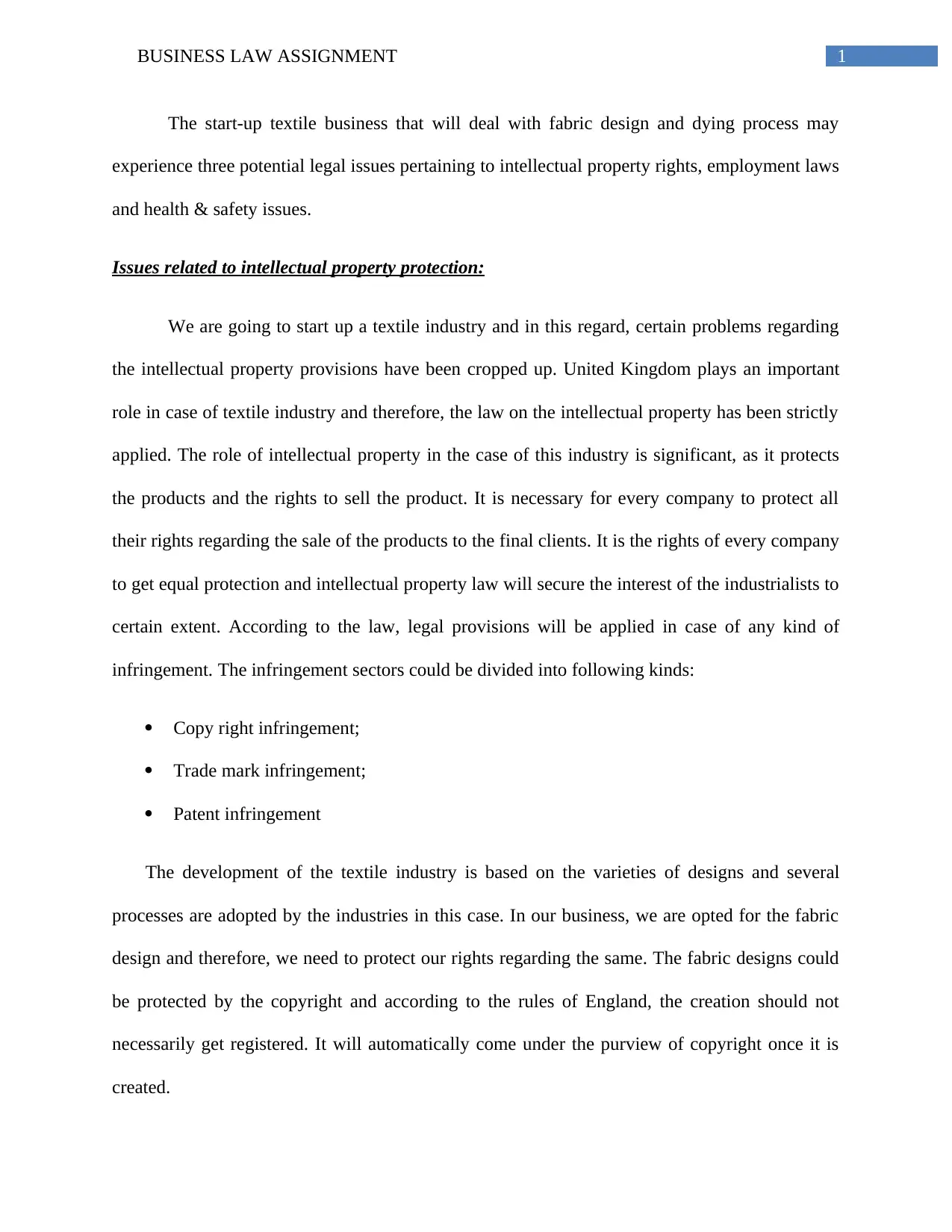
1BUSINESS LAW ASSIGNMENT
The start-up textile business that will deal with fabric design and dying process may
experience three potential legal issues pertaining to intellectual property rights, employment laws
and health & safety issues.
Issues related to intellectual property protection:
We are going to start up a textile industry and in this regard, certain problems regarding
the intellectual property provisions have been cropped up. United Kingdom plays an important
role in case of textile industry and therefore, the law on the intellectual property has been strictly
applied. The role of intellectual property in the case of this industry is significant, as it protects
the products and the rights to sell the product. It is necessary for every company to protect all
their rights regarding the sale of the products to the final clients. It is the rights of every company
to get equal protection and intellectual property law will secure the interest of the industrialists to
certain extent. According to the law, legal provisions will be applied in case of any kind of
infringement. The infringement sectors could be divided into following kinds:
Copy right infringement;
Trade mark infringement;
Patent infringement
The development of the textile industry is based on the varieties of designs and several
processes are adopted by the industries in this case. In our business, we are opted for the fabric
design and therefore, we need to protect our rights regarding the same. The fabric designs could
be protected by the copyright and according to the rules of England, the creation should not
necessarily get registered. It will automatically come under the purview of copyright once it is
created.
The start-up textile business that will deal with fabric design and dying process may
experience three potential legal issues pertaining to intellectual property rights, employment laws
and health & safety issues.
Issues related to intellectual property protection:
We are going to start up a textile industry and in this regard, certain problems regarding
the intellectual property provisions have been cropped up. United Kingdom plays an important
role in case of textile industry and therefore, the law on the intellectual property has been strictly
applied. The role of intellectual property in the case of this industry is significant, as it protects
the products and the rights to sell the product. It is necessary for every company to protect all
their rights regarding the sale of the products to the final clients. It is the rights of every company
to get equal protection and intellectual property law will secure the interest of the industrialists to
certain extent. According to the law, legal provisions will be applied in case of any kind of
infringement. The infringement sectors could be divided into following kinds:
Copy right infringement;
Trade mark infringement;
Patent infringement
The development of the textile industry is based on the varieties of designs and several
processes are adopted by the industries in this case. In our business, we are opted for the fabric
design and therefore, we need to protect our rights regarding the same. The fabric designs could
be protected by the copyright and according to the rules of England, the creation should not
necessarily get registered. It will automatically come under the purview of copyright once it is
created.
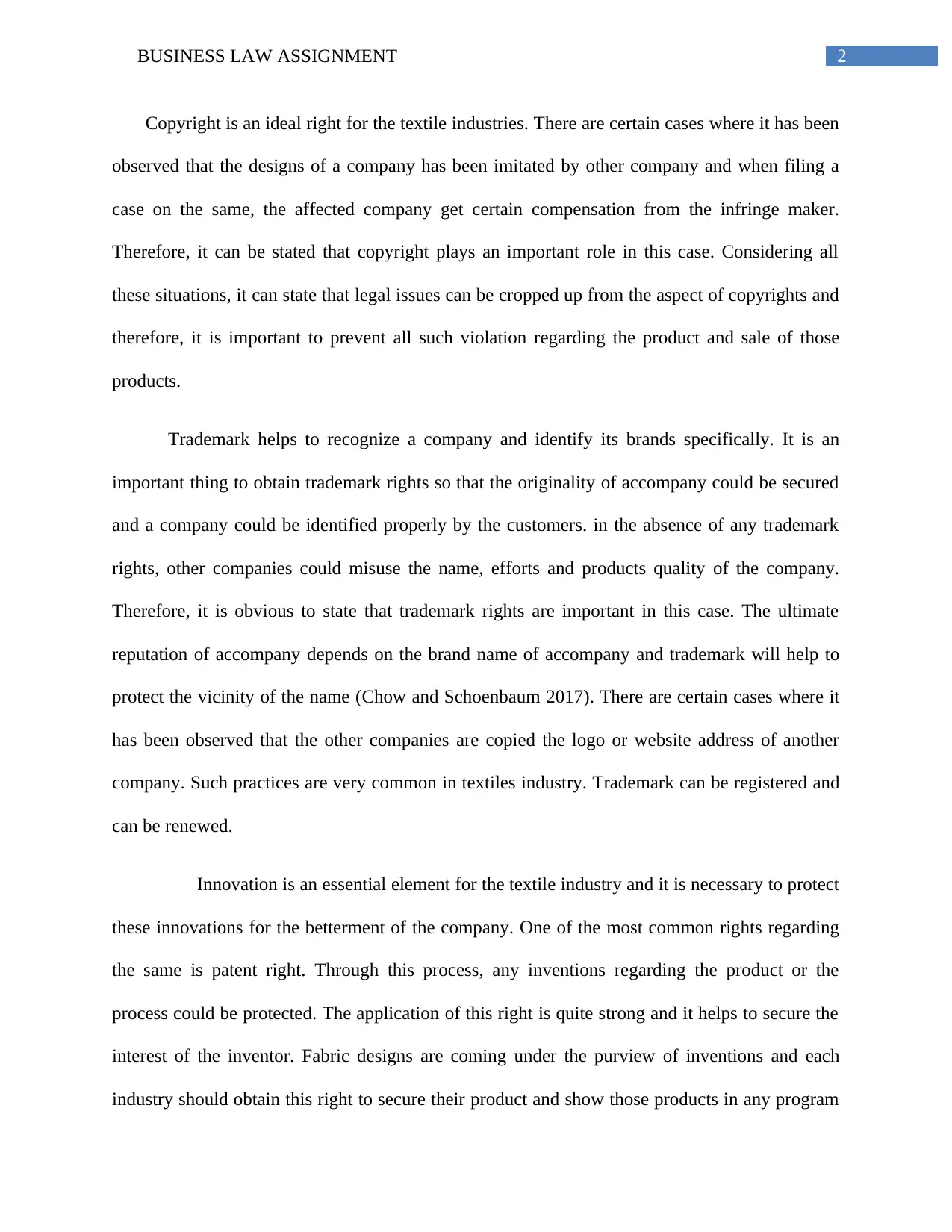
2BUSINESS LAW ASSIGNMENT
Copyright is an ideal right for the textile industries. There are certain cases where it has been
observed that the designs of a company has been imitated by other company and when filing a
case on the same, the affected company get certain compensation from the infringe maker.
Therefore, it can be stated that copyright plays an important role in this case. Considering all
these situations, it can state that legal issues can be cropped up from the aspect of copyrights and
therefore, it is important to prevent all such violation regarding the product and sale of those
products.
Trademark helps to recognize a company and identify its brands specifically. It is an
important thing to obtain trademark rights so that the originality of accompany could be secured
and a company could be identified properly by the customers. in the absence of any trademark
rights, other companies could misuse the name, efforts and products quality of the company.
Therefore, it is obvious to state that trademark rights are important in this case. The ultimate
reputation of accompany depends on the brand name of accompany and trademark will help to
protect the vicinity of the name (Chow and Schoenbaum 2017). There are certain cases where it
has been observed that the other companies are copied the logo or website address of another
company. Such practices are very common in textiles industry. Trademark can be registered and
can be renewed.
Innovation is an essential element for the textile industry and it is necessary to protect
these innovations for the betterment of the company. One of the most common rights regarding
the same is patent right. Through this process, any inventions regarding the product or the
process could be protected. The application of this right is quite strong and it helps to secure the
interest of the inventor. Fabric designs are coming under the purview of inventions and each
industry should obtain this right to secure their product and show those products in any program
Copyright is an ideal right for the textile industries. There are certain cases where it has been
observed that the designs of a company has been imitated by other company and when filing a
case on the same, the affected company get certain compensation from the infringe maker.
Therefore, it can be stated that copyright plays an important role in this case. Considering all
these situations, it can state that legal issues can be cropped up from the aspect of copyrights and
therefore, it is important to prevent all such violation regarding the product and sale of those
products.
Trademark helps to recognize a company and identify its brands specifically. It is an
important thing to obtain trademark rights so that the originality of accompany could be secured
and a company could be identified properly by the customers. in the absence of any trademark
rights, other companies could misuse the name, efforts and products quality of the company.
Therefore, it is obvious to state that trademark rights are important in this case. The ultimate
reputation of accompany depends on the brand name of accompany and trademark will help to
protect the vicinity of the name (Chow and Schoenbaum 2017). There are certain cases where it
has been observed that the other companies are copied the logo or website address of another
company. Such practices are very common in textiles industry. Trademark can be registered and
can be renewed.
Innovation is an essential element for the textile industry and it is necessary to protect
these innovations for the betterment of the company. One of the most common rights regarding
the same is patent right. Through this process, any inventions regarding the product or the
process could be protected. The application of this right is quite strong and it helps to secure the
interest of the inventor. Fabric designs are coming under the purview of inventions and each
industry should obtain this right to secure their product and show those products in any program
⊘ This is a preview!⊘
Do you want full access?
Subscribe today to unlock all pages.

Trusted by 1+ million students worldwide
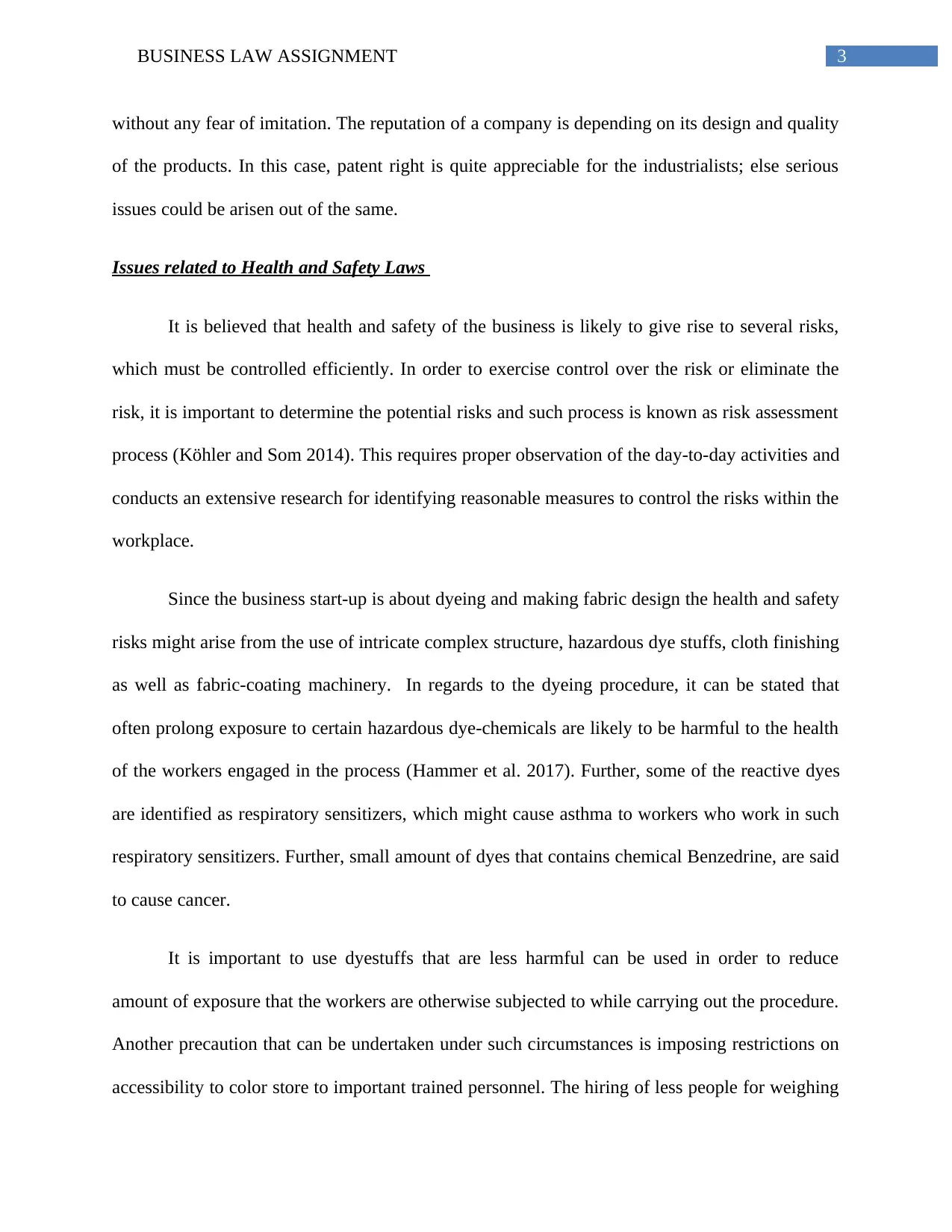
3BUSINESS LAW ASSIGNMENT
without any fear of imitation. The reputation of a company is depending on its design and quality
of the products. In this case, patent right is quite appreciable for the industrialists; else serious
issues could be arisen out of the same.
Issues related to Health and Safety Laws
It is believed that health and safety of the business is likely to give rise to several risks,
which must be controlled efficiently. In order to exercise control over the risk or eliminate the
risk, it is important to determine the potential risks and such process is known as risk assessment
process (Köhler and Som 2014). This requires proper observation of the day-to-day activities and
conducts an extensive research for identifying reasonable measures to control the risks within the
workplace.
Since the business start-up is about dyeing and making fabric design the health and safety
risks might arise from the use of intricate complex structure, hazardous dye stuffs, cloth finishing
as well as fabric-coating machinery. In regards to the dyeing procedure, it can be stated that
often prolong exposure to certain hazardous dye-chemicals are likely to be harmful to the health
of the workers engaged in the process (Hammer et al. 2017). Further, some of the reactive dyes
are identified as respiratory sensitizers, which might cause asthma to workers who work in such
respiratory sensitizers. Further, small amount of dyes that contains chemical Benzedrine, are said
to cause cancer.
It is important to use dyestuffs that are less harmful can be used in order to reduce
amount of exposure that the workers are otherwise subjected to while carrying out the procedure.
Another precaution that can be undertaken under such circumstances is imposing restrictions on
accessibility to color store to important trained personnel. The hiring of less people for weighing
without any fear of imitation. The reputation of a company is depending on its design and quality
of the products. In this case, patent right is quite appreciable for the industrialists; else serious
issues could be arisen out of the same.
Issues related to Health and Safety Laws
It is believed that health and safety of the business is likely to give rise to several risks,
which must be controlled efficiently. In order to exercise control over the risk or eliminate the
risk, it is important to determine the potential risks and such process is known as risk assessment
process (Köhler and Som 2014). This requires proper observation of the day-to-day activities and
conducts an extensive research for identifying reasonable measures to control the risks within the
workplace.
Since the business start-up is about dyeing and making fabric design the health and safety
risks might arise from the use of intricate complex structure, hazardous dye stuffs, cloth finishing
as well as fabric-coating machinery. In regards to the dyeing procedure, it can be stated that
often prolong exposure to certain hazardous dye-chemicals are likely to be harmful to the health
of the workers engaged in the process (Hammer et al. 2017). Further, some of the reactive dyes
are identified as respiratory sensitizers, which might cause asthma to workers who work in such
respiratory sensitizers. Further, small amount of dyes that contains chemical Benzedrine, are said
to cause cancer.
It is important to use dyestuffs that are less harmful can be used in order to reduce
amount of exposure that the workers are otherwise subjected to while carrying out the procedure.
Another precaution that can be undertaken under such circumstances is imposing restrictions on
accessibility to color store to important trained personnel. The hiring of less people for weighing
Paraphrase This Document
Need a fresh take? Get an instant paraphrase of this document with our AI Paraphraser
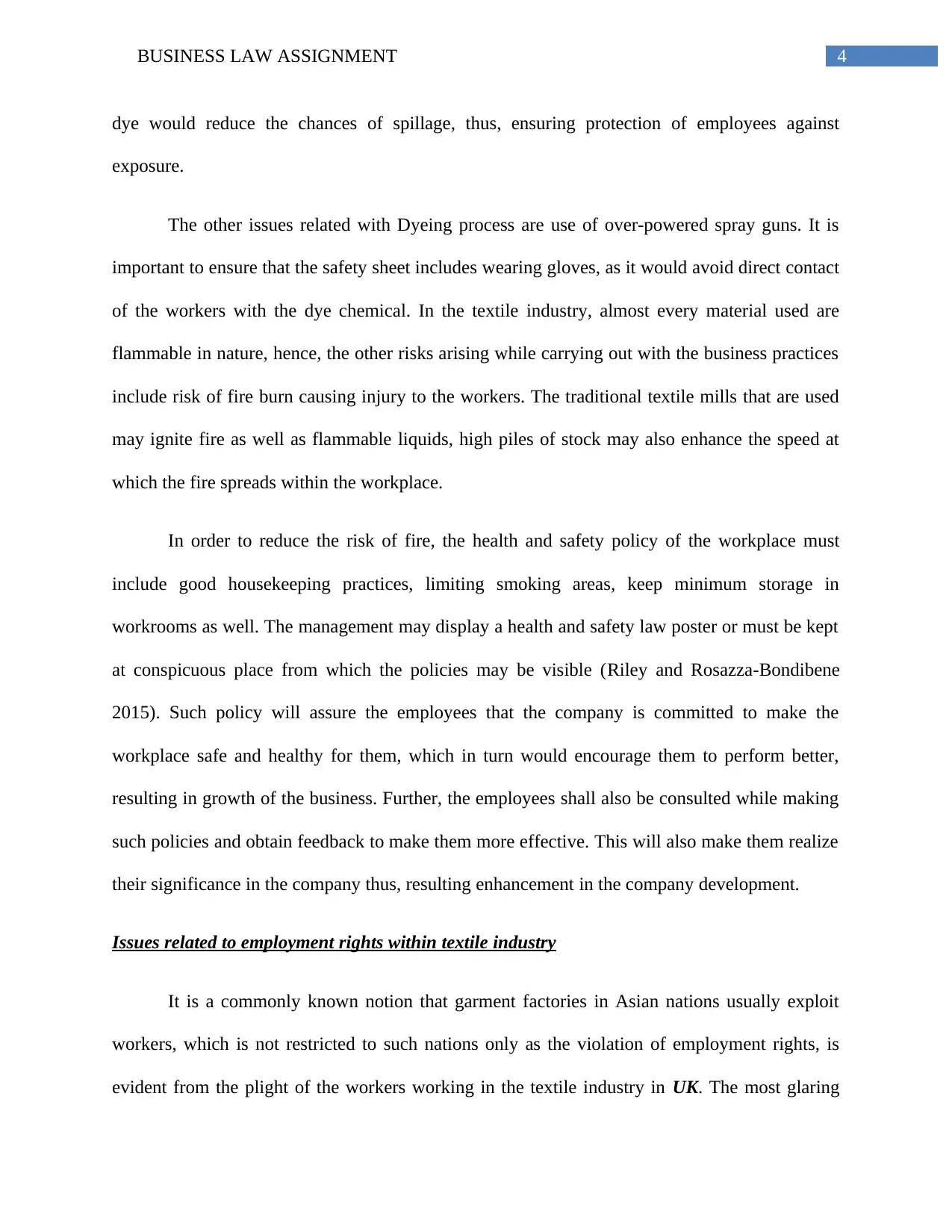
4BUSINESS LAW ASSIGNMENT
dye would reduce the chances of spillage, thus, ensuring protection of employees against
exposure.
The other issues related with Dyeing process are use of over-powered spray guns. It is
important to ensure that the safety sheet includes wearing gloves, as it would avoid direct contact
of the workers with the dye chemical. In the textile industry, almost every material used are
flammable in nature, hence, the other risks arising while carrying out with the business practices
include risk of fire burn causing injury to the workers. The traditional textile mills that are used
may ignite fire as well as flammable liquids, high piles of stock may also enhance the speed at
which the fire spreads within the workplace.
In order to reduce the risk of fire, the health and safety policy of the workplace must
include good housekeeping practices, limiting smoking areas, keep minimum storage in
workrooms as well. The management may display a health and safety law poster or must be kept
at conspicuous place from which the policies may be visible (Riley and Rosazza-Bondibene
2015). Such policy will assure the employees that the company is committed to make the
workplace safe and healthy for them, which in turn would encourage them to perform better,
resulting in growth of the business. Further, the employees shall also be consulted while making
such policies and obtain feedback to make them more effective. This will also make them realize
their significance in the company thus, resulting enhancement in the company development.
Issues related to employment rights within textile industry
It is a commonly known notion that garment factories in Asian nations usually exploit
workers, which is not restricted to such nations only as the violation of employment rights, is
evident from the plight of the workers working in the textile industry in UK. The most glaring
dye would reduce the chances of spillage, thus, ensuring protection of employees against
exposure.
The other issues related with Dyeing process are use of over-powered spray guns. It is
important to ensure that the safety sheet includes wearing gloves, as it would avoid direct contact
of the workers with the dye chemical. In the textile industry, almost every material used are
flammable in nature, hence, the other risks arising while carrying out with the business practices
include risk of fire burn causing injury to the workers. The traditional textile mills that are used
may ignite fire as well as flammable liquids, high piles of stock may also enhance the speed at
which the fire spreads within the workplace.
In order to reduce the risk of fire, the health and safety policy of the workplace must
include good housekeeping practices, limiting smoking areas, keep minimum storage in
workrooms as well. The management may display a health and safety law poster or must be kept
at conspicuous place from which the policies may be visible (Riley and Rosazza-Bondibene
2015). Such policy will assure the employees that the company is committed to make the
workplace safe and healthy for them, which in turn would encourage them to perform better,
resulting in growth of the business. Further, the employees shall also be consulted while making
such policies and obtain feedback to make them more effective. This will also make them realize
their significance in the company thus, resulting enhancement in the company development.
Issues related to employment rights within textile industry
It is a commonly known notion that garment factories in Asian nations usually exploit
workers, which is not restricted to such nations only as the violation of employment rights, is
evident from the plight of the workers working in the textile industry in UK. The most glaring
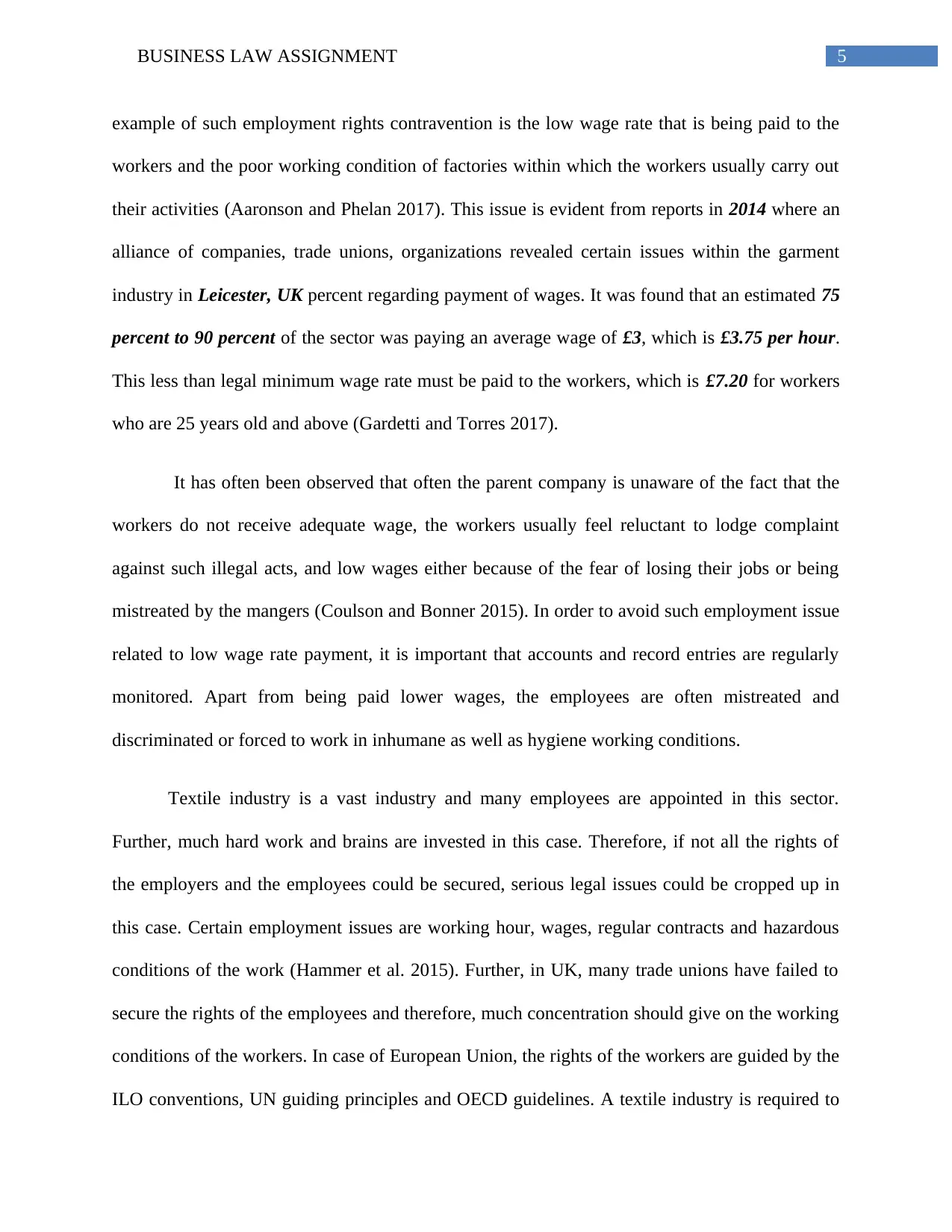
5BUSINESS LAW ASSIGNMENT
example of such employment rights contravention is the low wage rate that is being paid to the
workers and the poor working condition of factories within which the workers usually carry out
their activities (Aaronson and Phelan 2017). This issue is evident from reports in 2014 where an
alliance of companies, trade unions, organizations revealed certain issues within the garment
industry in Leicester, UK percent regarding payment of wages. It was found that an estimated 75
percent to 90 percent of the sector was paying an average wage of £3, which is £3.75 per hour.
This less than legal minimum wage rate must be paid to the workers, which is £7.20 for workers
who are 25 years old and above (Gardetti and Torres 2017).
It has often been observed that often the parent company is unaware of the fact that the
workers do not receive adequate wage, the workers usually feel reluctant to lodge complaint
against such illegal acts, and low wages either because of the fear of losing their jobs or being
mistreated by the mangers (Coulson and Bonner 2015). In order to avoid such employment issue
related to low wage rate payment, it is important that accounts and record entries are regularly
monitored. Apart from being paid lower wages, the employees are often mistreated and
discriminated or forced to work in inhumane as well as hygiene working conditions.
Textile industry is a vast industry and many employees are appointed in this sector.
Further, much hard work and brains are invested in this case. Therefore, if not all the rights of
the employers and the employees could be secured, serious legal issues could be cropped up in
this case. Certain employment issues are working hour, wages, regular contracts and hazardous
conditions of the work (Hammer et al. 2015). Further, in UK, many trade unions have failed to
secure the rights of the employees and therefore, much concentration should give on the working
conditions of the workers. In case of European Union, the rights of the workers are guided by the
ILO conventions, UN guiding principles and OECD guidelines. A textile industry is required to
example of such employment rights contravention is the low wage rate that is being paid to the
workers and the poor working condition of factories within which the workers usually carry out
their activities (Aaronson and Phelan 2017). This issue is evident from reports in 2014 where an
alliance of companies, trade unions, organizations revealed certain issues within the garment
industry in Leicester, UK percent regarding payment of wages. It was found that an estimated 75
percent to 90 percent of the sector was paying an average wage of £3, which is £3.75 per hour.
This less than legal minimum wage rate must be paid to the workers, which is £7.20 for workers
who are 25 years old and above (Gardetti and Torres 2017).
It has often been observed that often the parent company is unaware of the fact that the
workers do not receive adequate wage, the workers usually feel reluctant to lodge complaint
against such illegal acts, and low wages either because of the fear of losing their jobs or being
mistreated by the mangers (Coulson and Bonner 2015). In order to avoid such employment issue
related to low wage rate payment, it is important that accounts and record entries are regularly
monitored. Apart from being paid lower wages, the employees are often mistreated and
discriminated or forced to work in inhumane as well as hygiene working conditions.
Textile industry is a vast industry and many employees are appointed in this sector.
Further, much hard work and brains are invested in this case. Therefore, if not all the rights of
the employers and the employees could be secured, serious legal issues could be cropped up in
this case. Certain employment issues are working hour, wages, regular contracts and hazardous
conditions of the work (Hammer et al. 2015). Further, in UK, many trade unions have failed to
secure the rights of the employees and therefore, much concentration should give on the working
conditions of the workers. In case of European Union, the rights of the workers are guided by the
ILO conventions, UN guiding principles and OECD guidelines. A textile industry is required to
⊘ This is a preview!⊘
Do you want full access?
Subscribe today to unlock all pages.

Trusted by 1+ million students worldwide
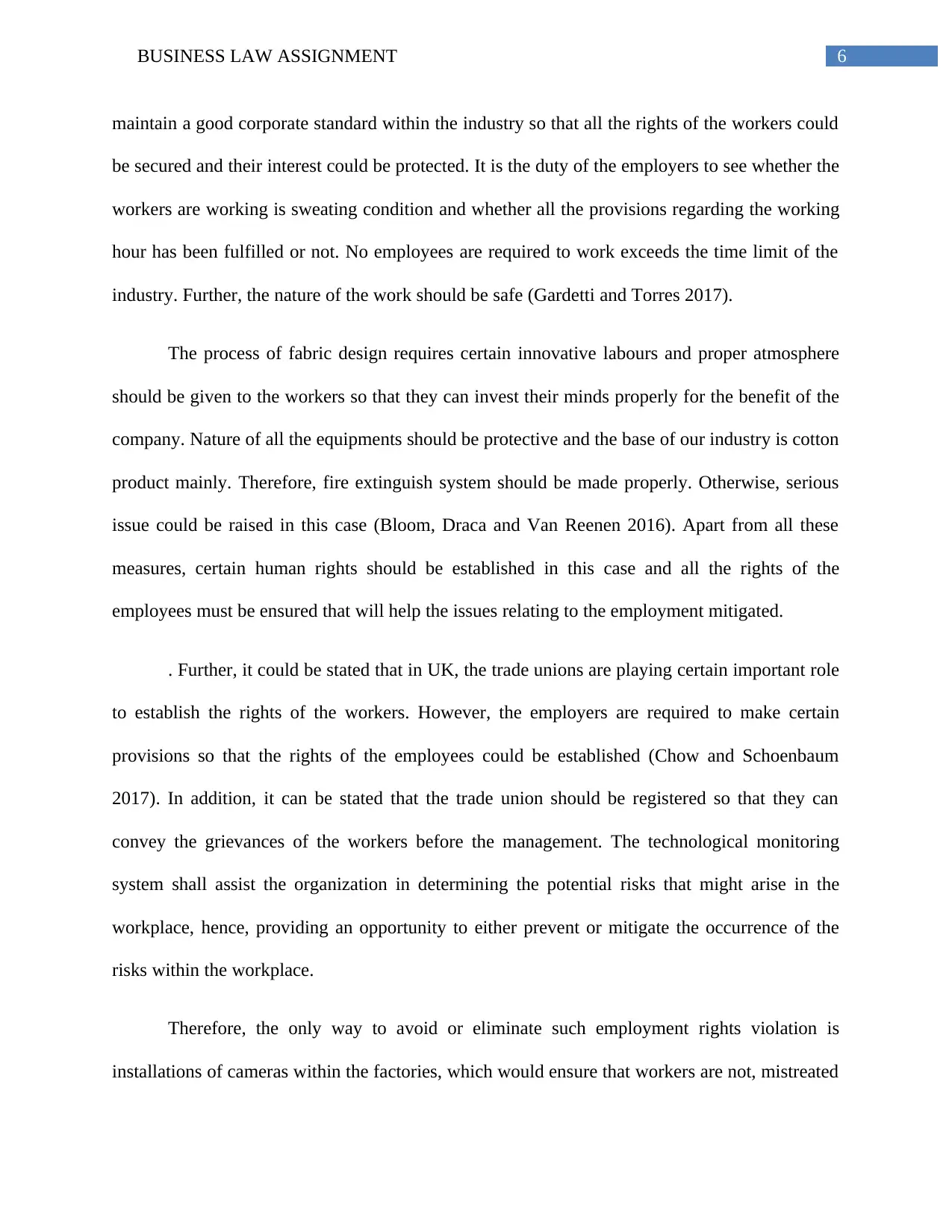
6BUSINESS LAW ASSIGNMENT
maintain a good corporate standard within the industry so that all the rights of the workers could
be secured and their interest could be protected. It is the duty of the employers to see whether the
workers are working is sweating condition and whether all the provisions regarding the working
hour has been fulfilled or not. No employees are required to work exceeds the time limit of the
industry. Further, the nature of the work should be safe (Gardetti and Torres 2017).
The process of fabric design requires certain innovative labours and proper atmosphere
should be given to the workers so that they can invest their minds properly for the benefit of the
company. Nature of all the equipments should be protective and the base of our industry is cotton
product mainly. Therefore, fire extinguish system should be made properly. Otherwise, serious
issue could be raised in this case (Bloom, Draca and Van Reenen 2016). Apart from all these
measures, certain human rights should be established in this case and all the rights of the
employees must be ensured that will help the issues relating to the employment mitigated.
. Further, it could be stated that in UK, the trade unions are playing certain important role
to establish the rights of the workers. However, the employers are required to make certain
provisions so that the rights of the employees could be established (Chow and Schoenbaum
2017). In addition, it can be stated that the trade union should be registered so that they can
convey the grievances of the workers before the management. The technological monitoring
system shall assist the organization in determining the potential risks that might arise in the
workplace, hence, providing an opportunity to either prevent or mitigate the occurrence of the
risks within the workplace.
Therefore, the only way to avoid or eliminate such employment rights violation is
installations of cameras within the factories, which would ensure that workers are not, mistreated
maintain a good corporate standard within the industry so that all the rights of the workers could
be secured and their interest could be protected. It is the duty of the employers to see whether the
workers are working is sweating condition and whether all the provisions regarding the working
hour has been fulfilled or not. No employees are required to work exceeds the time limit of the
industry. Further, the nature of the work should be safe (Gardetti and Torres 2017).
The process of fabric design requires certain innovative labours and proper atmosphere
should be given to the workers so that they can invest their minds properly for the benefit of the
company. Nature of all the equipments should be protective and the base of our industry is cotton
product mainly. Therefore, fire extinguish system should be made properly. Otherwise, serious
issue could be raised in this case (Bloom, Draca and Van Reenen 2016). Apart from all these
measures, certain human rights should be established in this case and all the rights of the
employees must be ensured that will help the issues relating to the employment mitigated.
. Further, it could be stated that in UK, the trade unions are playing certain important role
to establish the rights of the workers. However, the employers are required to make certain
provisions so that the rights of the employees could be established (Chow and Schoenbaum
2017). In addition, it can be stated that the trade union should be registered so that they can
convey the grievances of the workers before the management. The technological monitoring
system shall assist the organization in determining the potential risks that might arise in the
workplace, hence, providing an opportunity to either prevent or mitigate the occurrence of the
risks within the workplace.
Therefore, the only way to avoid or eliminate such employment rights violation is
installations of cameras within the factories, which would ensure that workers are not, mistreated
Paraphrase This Document
Need a fresh take? Get an instant paraphrase of this document with our AI Paraphraser
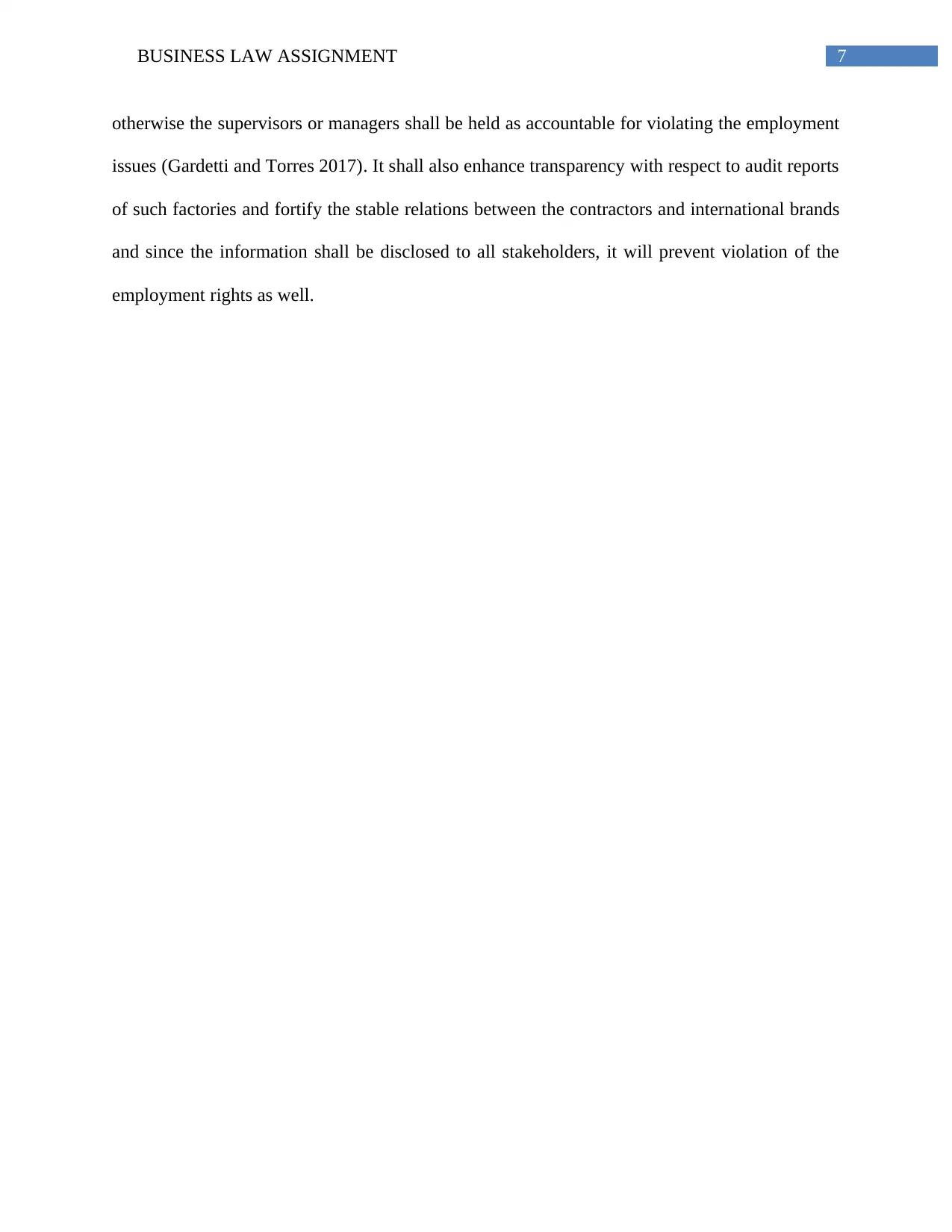
7BUSINESS LAW ASSIGNMENT
otherwise the supervisors or managers shall be held as accountable for violating the employment
issues (Gardetti and Torres 2017). It shall also enhance transparency with respect to audit reports
of such factories and fortify the stable relations between the contractors and international brands
and since the information shall be disclosed to all stakeholders, it will prevent violation of the
employment rights as well.
otherwise the supervisors or managers shall be held as accountable for violating the employment
issues (Gardetti and Torres 2017). It shall also enhance transparency with respect to audit reports
of such factories and fortify the stable relations between the contractors and international brands
and since the information shall be disclosed to all stakeholders, it will prevent violation of the
employment rights as well.
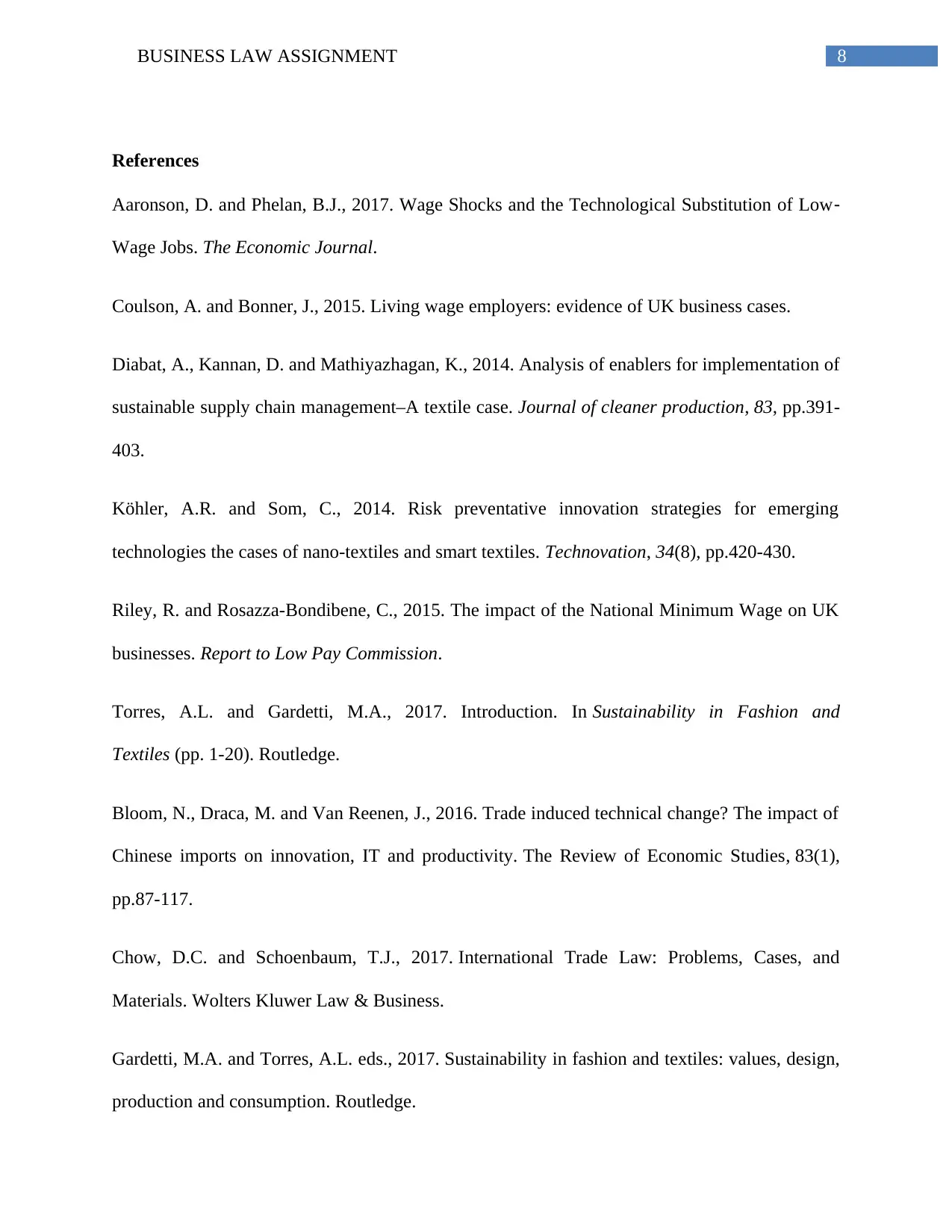
8BUSINESS LAW ASSIGNMENT
References
Aaronson, D. and Phelan, B.J., 2017. Wage Shocks and the Technological Substitution of Low‐
Wage Jobs. The Economic Journal.
Coulson, A. and Bonner, J., 2015. Living wage employers: evidence of UK business cases.
Diabat, A., Kannan, D. and Mathiyazhagan, K., 2014. Analysis of enablers for implementation of
sustainable supply chain management–A textile case. Journal of cleaner production, 83, pp.391-
403.
Köhler, A.R. and Som, C., 2014. Risk preventative innovation strategies for emerging
technologies the cases of nano-textiles and smart textiles. Technovation, 34(8), pp.420-430.
Riley, R. and Rosazza-Bondibene, C., 2015. The impact of the National Minimum Wage on UK
businesses. Report to Low Pay Commission.
Torres, A.L. and Gardetti, M.A., 2017. Introduction. In Sustainability in Fashion and
Textiles (pp. 1-20). Routledge.
Bloom, N., Draca, M. and Van Reenen, J., 2016. Trade induced technical change? The impact of
Chinese imports on innovation, IT and productivity. The Review of Economic Studies, 83(1),
pp.87-117.
Chow, D.C. and Schoenbaum, T.J., 2017. International Trade Law: Problems, Cases, and
Materials. Wolters Kluwer Law & Business.
Gardetti, M.A. and Torres, A.L. eds., 2017. Sustainability in fashion and textiles: values, design,
production and consumption. Routledge.
References
Aaronson, D. and Phelan, B.J., 2017. Wage Shocks and the Technological Substitution of Low‐
Wage Jobs. The Economic Journal.
Coulson, A. and Bonner, J., 2015. Living wage employers: evidence of UK business cases.
Diabat, A., Kannan, D. and Mathiyazhagan, K., 2014. Analysis of enablers for implementation of
sustainable supply chain management–A textile case. Journal of cleaner production, 83, pp.391-
403.
Köhler, A.R. and Som, C., 2014. Risk preventative innovation strategies for emerging
technologies the cases of nano-textiles and smart textiles. Technovation, 34(8), pp.420-430.
Riley, R. and Rosazza-Bondibene, C., 2015. The impact of the National Minimum Wage on UK
businesses. Report to Low Pay Commission.
Torres, A.L. and Gardetti, M.A., 2017. Introduction. In Sustainability in Fashion and
Textiles (pp. 1-20). Routledge.
Bloom, N., Draca, M. and Van Reenen, J., 2016. Trade induced technical change? The impact of
Chinese imports on innovation, IT and productivity. The Review of Economic Studies, 83(1),
pp.87-117.
Chow, D.C. and Schoenbaum, T.J., 2017. International Trade Law: Problems, Cases, and
Materials. Wolters Kluwer Law & Business.
Gardetti, M.A. and Torres, A.L. eds., 2017. Sustainability in fashion and textiles: values, design,
production and consumption. Routledge.
⊘ This is a preview!⊘
Do you want full access?
Subscribe today to unlock all pages.

Trusted by 1+ million students worldwide
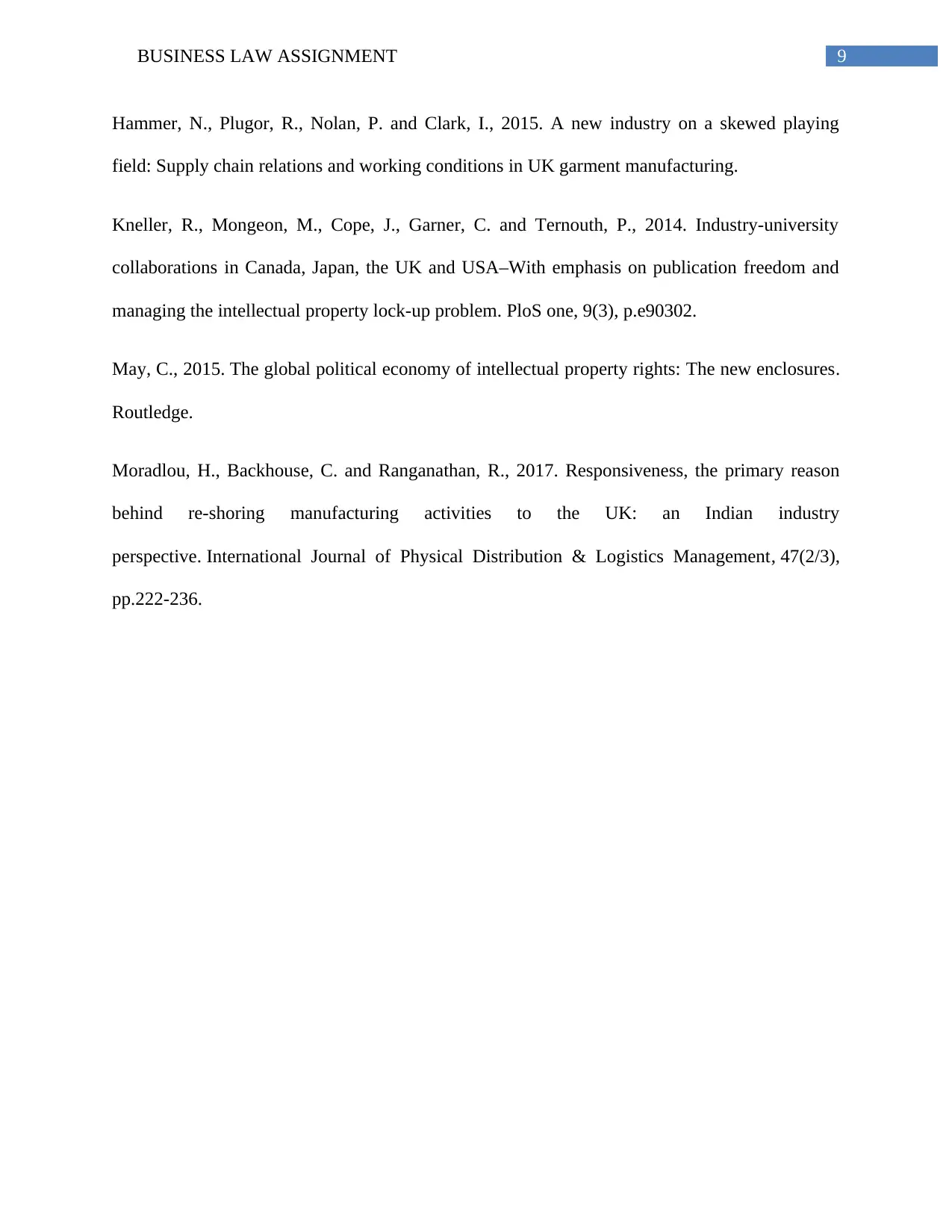
9BUSINESS LAW ASSIGNMENT
Hammer, N., Plugor, R., Nolan, P. and Clark, I., 2015. A new industry on a skewed playing
field: Supply chain relations and working conditions in UK garment manufacturing.
Kneller, R., Mongeon, M., Cope, J., Garner, C. and Ternouth, P., 2014. Industry-university
collaborations in Canada, Japan, the UK and USA–With emphasis on publication freedom and
managing the intellectual property lock-up problem. PloS one, 9(3), p.e90302.
May, C., 2015. The global political economy of intellectual property rights: The new enclosures.
Routledge.
Moradlou, H., Backhouse, C. and Ranganathan, R., 2017. Responsiveness, the primary reason
behind re-shoring manufacturing activities to the UK: an Indian industry
perspective. International Journal of Physical Distribution & Logistics Management, 47(2/3),
pp.222-236.
Hammer, N., Plugor, R., Nolan, P. and Clark, I., 2015. A new industry on a skewed playing
field: Supply chain relations and working conditions in UK garment manufacturing.
Kneller, R., Mongeon, M., Cope, J., Garner, C. and Ternouth, P., 2014. Industry-university
collaborations in Canada, Japan, the UK and USA–With emphasis on publication freedom and
managing the intellectual property lock-up problem. PloS one, 9(3), p.e90302.
May, C., 2015. The global political economy of intellectual property rights: The new enclosures.
Routledge.
Moradlou, H., Backhouse, C. and Ranganathan, R., 2017. Responsiveness, the primary reason
behind re-shoring manufacturing activities to the UK: an Indian industry
perspective. International Journal of Physical Distribution & Logistics Management, 47(2/3),
pp.222-236.
1 out of 10
Related Documents
Your All-in-One AI-Powered Toolkit for Academic Success.
+13062052269
info@desklib.com
Available 24*7 on WhatsApp / Email
![[object Object]](/_next/static/media/star-bottom.7253800d.svg)
Unlock your academic potential
Copyright © 2020–2025 A2Z Services. All Rights Reserved. Developed and managed by ZUCOL.




